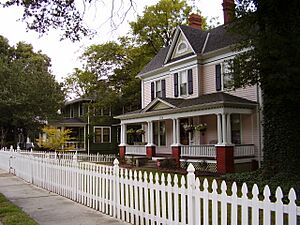Dunleath Historical District facts for kids
The Dunleath Historic District is a cool neighborhood in Greensboro, North Carolina, a city in the United States. This area is known for its many old homes built in the late 1800s and early 1900s. Dunleath is one of three special historic districts in Greensboro.
The neighborhood was named after a large house that used to belong to Robert Dick, one of the first people to live there. Before 2017, it was called the Charles B. Aycock Historic District. The name was changed, and even a middle school in the area changed its name from Aycock to Swann.
Contents
Exploring Dunleath
Where is Dunleath?
Dunleath is located in the northeast part of Greensboro. It has clear boundaries:
- To the north, you'll find East Bessemer Avenue.
- To the west, there are the Southern Railway train tracks.
- To the east, it's bordered by Lindsay Street.
- To the south, you'll see Murrow Boulevard.
What's the ZIP Code?
The ZIP code for Dunleath is 27405. This code covers most, if not all, of the neighborhood.
A Look Back in Time: Dunleath's History
The story of Dunleath began in 1895. A rich textile owner named Caesar Cone built and paved Summit Avenue. This new road connected downtown Greensboro to Cone's factories. Because of its great location between downtown and the mills, Dunleath quickly became a popular place to live.
People built big, fancy homes here. Many of these houses were in the Queen Anne style. They often had cool turrets (small towers), porches with pretty wooden decorations, and unique window shapes. Later, houses were built in styles like Colonial Revival and Craftsman. But almost all the homes in Dunleath share some features: wide front porches, old, tall trees, and large rooms inside.
In the 1970s, artists and designers "rediscovered" the neighborhood. They loved the big rooms and fair prices of the homes. Dunleath is separated from another historic area, the Fisher Park Historic District, by train tracks.
The people of Dunleath are very involved in their community. In 2003, they worked hard to keep major league baseball in their neighborhood. They also have big plans to improve the Summit Avenue area. Residents are excited about new businesses and homes being built on empty land along the avenue. They are working to connect their part of the city even more with downtown Greensboro.
Cool Places to Visit in Dunleath
There are several interesting spots in the Dunleath Historic District:
- World War Memorial Stadium at 510 Yanceyville Street: This stadium was built to honor soldiers from World War I. Many famous baseball players have played here, including Jackie Robinson, Mickey Mantle, Carl Yastrzemski, Roger Maris, and Derek Jeter. It's a great place for sports history fans!
- Greensboro Farmers' Curb Market at 501 Yanceyville Street: This market is open all year. You can find fresh flowers, yummy foods, and local produce here. It's a fun place to explore and see what local farmers are growing.
- Notable Houses:
- The Vaught House at 519 Summit Avenue looks like a castle!
- The Sigmund Sternberger House at 712 Summit Avenue has a Mediterranean style, making it look like it belongs in a sunny, warm country.
- Swann Middle School at 811 Cyprus Street was designed by a famous New York company called Starrett and Van Vleck.
Parks and Public Spaces
Dunleath also has nice green spaces for everyone to enjoy:
- Sterberger Park
- World War Memorial Stadium
- Greensboro Curb Market
Historic Recognition
The Summit Avenue National Register Historic District was officially recognized in 1993. This means the area is considered very important for its history and architecture.


